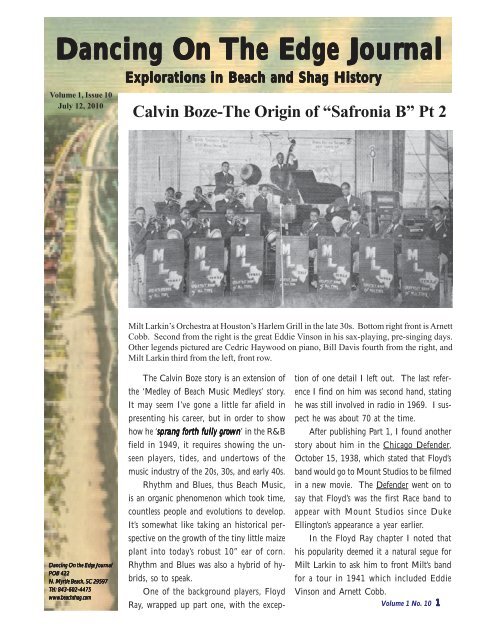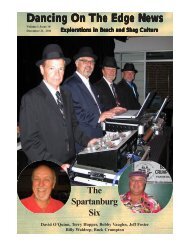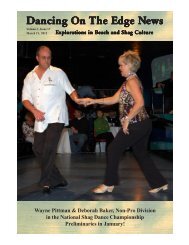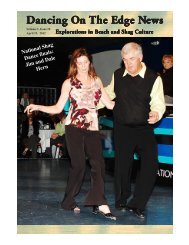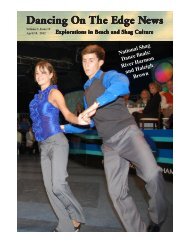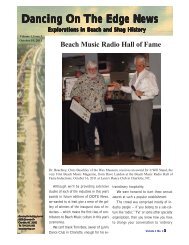Dancing On the Edge Journal - Beach Music
Dancing On the Edge Journal - Beach Music
Dancing On the Edge Journal - Beach Music
- No tags were found...
Create successful ePaper yourself
Turn your PDF publications into a flip-book with our unique Google optimized e-Paper software.
<strong>Dancing</strong> <strong>On</strong> The <strong>Edge</strong> JourournalnalVolume 1, Issue 10July 12, 2010Explorations in <strong>Beach</strong> and Shag HistoryCalvin Boze-The Origin of “Safronia B” Pt 2Milt Larkin’s Orchestra at Houston’s Harlem Grill in <strong>the</strong> late 30s. Bottom right front is ArnettCobb. Second from <strong>the</strong> right is <strong>the</strong> great Eddie Vinson in his sax-playing, pre-singing days.O<strong>the</strong>r legends pictured are Cedric Haywood on piano, Bill Davis fourth from <strong>the</strong> right, andMilt Larkin third from <strong>the</strong> left, front row.<strong>Dancing</strong> <strong>On</strong> <strong>the</strong> <strong>Edge</strong> <strong>Journal</strong>POB 422N. Myrtle <strong>Beach</strong>, SC 29597Tel: 843-602-4475www.beachshag.comThe Calvin Boze story is an extension of<strong>the</strong> ‘Medley of <strong>Beach</strong> <strong>Music</strong> Medleys’ story.It may seem I’ve gone a little far afield inpresenting his career, but in order to showhow he ‘sprsprang ang forth th fully grownwn’ in <strong>the</strong> R&Bfield in 1949, it requires showing <strong>the</strong> unseenplayers, tides, and undertows of <strong>the</strong>music industry of <strong>the</strong> 20s, 30s, and early 40s.Rhythm and Blues, thus <strong>Beach</strong> <strong>Music</strong>,is an organic phenomenon which took time,countless people and evolutions to develop.It’s somewhat like taking an historical perspectiveon <strong>the</strong> growth of <strong>the</strong> tiny little maizeplant into today’s robust 10” ear of corn.Rhythm and Blues was also a hybrid of hybrids,so to speak.<strong>On</strong>e of <strong>the</strong> background players, FloydRay, wrapped up part one, with <strong>the</strong> excep-tion of one detail I left out. The last referenceI find on him was second hand, statinghe was still involved in radio in 1969. I suspec<strong>the</strong> was about 70 at <strong>the</strong> time.After publishing Part 1, I found ano<strong>the</strong>rstory about him in <strong>the</strong> Chicago Defender,October 15, 1938, which stated that Floyd’sband would go to Mount Studios to be filmedin a new movie. The Defender went on tosay that Floyd’s was <strong>the</strong> first Race band toappear with Mount Studios since DukeEllington’s appearance a year earlier.In <strong>the</strong> Floyd Ray chapter I noted thathis popularity deemed it a natural segue forMilt Larkin to ask him to front Milt’s bandfor a tour in 1941 which included EddieVinson and Arnett Cobb.Volume 1 No. 10 1
Vintage GroooovesMilt Larkin -Last of <strong>the</strong> Greateat Texas Big ig BandsThe Milt Larkin band was an important steppingstone in Calvin Boze’ career. But I’m getting ahead of<strong>the</strong> story.From <strong>the</strong> Galveston Daily News, September 2, 1933.From <strong>the</strong> Lubbock, Texas Morning Avalanche, October15, 1932.Although Larkin’s unit was considered to be one of<strong>the</strong> greatest of all <strong>the</strong> territory bands, <strong>the</strong>y never recorded.Milt was born in Navasota, Texas October 10, 1910.He taught himself to play trumpet after hearing NewOrleans’ Bunk Johnson on a road trip. Up until 1935he freelanced with bands like Chester Boone and HisTen Cotton Pickers and <strong>the</strong> Giles Mitchell BirminghamBlue Blowers. From 1936 to 1942 he toured with hisMilt Larkin seated front and center with his band.From <strong>the</strong> Victoria (Texas) Advocate, January 18, 1934.<strong>On</strong>ce you’ve seen his personnel lineup that’s all <strong>the</strong> moredisappointing.2 <strong>Dancing</strong> <strong>On</strong> <strong>the</strong> <strong>Edge</strong> <strong>Journal</strong>own band throughout <strong>the</strong> Southwest, with occasionalengagements in Kansas City, Chicago, and <strong>the</strong> ApolloTheatre in New York.How long did Milt have to develop his chops beforehe started his own band? The Chester Boone ad from1932 above is <strong>the</strong> earliest I could find in Texas newspapersand <strong>the</strong> Birmingham Blue Blowers ad from 1934was <strong>the</strong> earliest I could come up with.
Vintage GroooovesThere’s a photo of Milt’sband from 1936 or 37 thatshows his band was loadedwith future stars such as EddieVinson, Arnett Cobb, CedricHaywood, trumpeters LonnieMoore and Lester Patterson,Henry Sloan on trombone ando<strong>the</strong>rs.A picture in 1938 showsthat Bill Davis, <strong>the</strong> future“Wild Bill” was added for guitar,piano, and arranger.Down Beat in July 1939shared <strong>the</strong> observations ofMilt Larkins band at <strong>the</strong> Rhumboogie Club, Chicago, 1941. Left: Cedric Haywoodon piano, Lawrence Cato bass, Milt in <strong>the</strong> white jacket, Alvin Burroughs <strong>the</strong> drummer.Trumpets: Calvin Ladnier, Clarence Trice, Jesse Miller. Trombones: ArnettAmerican music critic, musician,and producer, John Hammond Sparrow, ‘Streamline’ Williams. Saxophones: Frank Dominguez, Ernest “Tom”who heard Larkin’s 14-piece Archia, Moses Ga nt, and Sam Player. The band had already been ‘picked over’ byband in Beaumont, Texas andLionel Hampton and Cootie Williams.stated he was impressed.would end up in a battle with him, and ‘honking’That same year Illinois Jacquet played tenor sax wi<strong>the</strong>merged from those battles.Milt (Larkin said once that Illinois played alto sax withIn 1941, Milt Larkin went to Chicago for a twoweekstint at Joe Louis’s Rhumboogie Club and endedhis band before switching to and becoming one of <strong>the</strong>giants of <strong>the</strong> tenor sax), T-Bone Walker offered his guitarup staying nine months. T-Bone Walker would sometimescome in off <strong>the</strong> road and play with Milt <strong>the</strong>re.and vocals that year, and Joe Marshall played drums with<strong>the</strong> band.During <strong>the</strong>ir Rhumboogie run, Lionel Hampton andDown Beat’s September 1, 1940 issue listed Larkin’spersonnel as including Eddie Vinson, Tom Archia, ArnettCobb, Cedric Heywood and Tommy Ladnier’s bro<strong>the</strong>rCalvin.Heywood, who was with <strong>the</strong> band from 1936-40and again in 1942 remembers Russell Jacquet playingfor awhile with <strong>the</strong> band.Unfortunately, Larkin refused to record during <strong>the</strong>peak years of his success in <strong>the</strong> 30s and early 40s becauseof <strong>the</strong> low wages that record companies offered to blackmusicians.Larkin is quoted as claiming that <strong>the</strong> ‘honking’ ofsaxophones began with <strong>the</strong> saxophone battles that hisband engaged in. Whoever sat next to Arnett CobbVolume 1 No. 10 3
Vintage GroooovesCootie Williams often stopped by to listen, and ‘recruit’some of Milt’s players (Eddie Vinson had a fine careerwith Cootie Williams soonafter. Harry Sloan, and Illi-4 <strong>Dancing</strong> <strong>On</strong> <strong>the</strong> <strong>Edge</strong> <strong>Journal</strong>nois Jacquet were both recording with Lionel in December1941.).Like countless o<strong>the</strong>r musicians, Milt’s career in <strong>the</strong>early to mid 40s was redirected dramatically by America’sentrance into World War II in 1942. It may have comejust in time, so many of his band members had been‘drafted’ he was ready to close up shop when he wasdrafted in November 1943 to play trumpet and valvetrombone in Sy Oliver’s service band.The August 26, 1946 Down Beat reported he wasjust out of <strong>the</strong> Army and rehearsing a 17-piece orchestrain New York. He played some at <strong>the</strong> Rhumboogie Cluband went on <strong>the</strong> road with <strong>the</strong>m for awhile.Despite Down Beat’s announcement that Milton was justout of <strong>the</strong> Army in August, I found this ad in <strong>the</strong> DanvilleBee, for a dance in Martinsville, Va, March 6, 1946.
Vintage GroooovesI think Milton must’ve had a special arrangementwith <strong>the</strong> Army before he was released. He FINALLY gotinto <strong>the</strong> recording studio in early 1946, with a song thatmade <strong>the</strong> Billboard Advance Record Release chart May18, 1946. Note that it lists “Chicken Blues” by CorporalMilton Larkins--he was still in <strong>the</strong> Army.artists, and undocumented songs I found).It gets even more interesting.I have some extraordinary research resources I’ve collectedover <strong>the</strong> years. When I go to look up <strong>the</strong> discographyor biography of an artist I expect to get a completelisting.My master discography shows Milt Larkins next recordingwas in New York in 1947 and issued as a twosidedrecord on Sunrise. However, subsequent explorationhas uncovered something I have not imagined inyears -- <strong>the</strong>re’s an enormous body of Rhythm & Bluesmaterial that still hasn’t been documented. I make thatstatement on <strong>the</strong> discovery that Milt recorded four moresides in 1947, issued on Sonora records # 116 & 117,but those are not listed in any of <strong>the</strong> standard, or rare,volumes I can find. (I’ll have more to say about this later-- I’m currently compiling <strong>the</strong> massive amount of records,September 24, 1946, Galveston News. Milton Larkin andHis Orchestra were road tripping with one of <strong>the</strong> hot, upand coming bands at <strong>the</strong> time -- Bill Samuels with <strong>the</strong>Cats ‘n Jammers.Volume 1 No. 10 5
Vintage GroooovesMilt is listed on Apollo 394 with “Big League Blues,”which came out in January 1948. As it turns out, thatwas part of his old bandmate from <strong>the</strong> late 30s, ArnettCobb’s, recording session in <strong>the</strong> autumn of 1947. Arnetthad gone independent after many years with LionelHampton, also backing Dinah Washington on many ofher early recordings with <strong>the</strong> Hampton unit.Milton joined Arnett for vocals on “Chick She Ain’tNowhere” on Apollo 784, and o<strong>the</strong>r side of Apollo 394,“Flower Garden Blues.”In December 1948, Milt and his group <strong>the</strong> X-Raysrecorded six sides with <strong>the</strong> Hal Singer Sextet for Savoy6 <strong>Dancing</strong> <strong>On</strong> <strong>the</strong> <strong>Edge</strong> <strong>Journal</strong>records in New Jersey on December 10th. That sessionincluded a rare Shag favorite, “I’ll Always Be In LoveWith You” with Milt on <strong>the</strong> lead. O<strong>the</strong>r sides were:“Beef Stew”“Neck Bones”“<strong>On</strong>e for Willie”“Teddy’s Dream” and an untitled, unissued track.<strong>On</strong> January 12, 1949, Milton joined again with HalSinger, with <strong>the</strong> addition of <strong>the</strong> great trumpeter BuckClayton for four sides recorded for Savoy, but were neverissued.Brownie McGhee and <strong>the</strong> X-Rays appeared inBillboard’s Rhythmand Blues Record Reviewson August 12,1950 with two sideson Savoy 760. “YouGot to Love Me Baby”and <strong>the</strong> Shag-favored“Feed Me Baby” bothwere <strong>the</strong> X-Rays, MiltLarkin’s group, thus,he was most certainlypart of <strong>the</strong> recordings.Early in 1951Milt was back in <strong>the</strong>studio with <strong>the</strong> X-Rays recording twosongs for RegalRecords, “Best FriendBlues,” and an attemptto cash in on <strong>the</strong>huge popularity of“Tennessee Waltz.”<strong>On</strong> February 23,1951 he was accompaniedby HowardBiggs and his Orchestrafor two sides for Regalrecords...Standard reference works list Milton Larkin with only one song in 1947, however this Septembr7 chart from Billboard shows two o<strong>the</strong>rs on Sonora Records not in <strong>the</strong> master discography.
Vintage GroooovesLater that year, October 20th, <strong>the</strong>y recorded fourmore songs toge<strong>the</strong>r for Coral records, with <strong>the</strong> X-Rayssinging lead on two, “Charmaine,” and “I’ve Got A Pocketfulof Dreams.”<strong>On</strong> February 12, 1952, Milton was in <strong>the</strong> studiowith <strong>the</strong> Ace Harris Orchestra recording four sides forCoral records.There were twoo<strong>the</strong>r records byMilton, one onLloyds 45-110,“Tippin’ In b/w It’s ACrime,” and <strong>the</strong>o<strong>the</strong>r on Hub 3042,“My No Good ManOk, I’m embarrassed. This is b/w Jelly Roll Blues.”a really bad scan of <strong>the</strong> X- I’m not yet sure aboutRays’ “I’ll Always Be In Love ei<strong>the</strong>r of those. TheWith You,” but I ran out of timeLloyds 110 record isbefore going ‘to press.’definitely by <strong>the</strong> Larksfrom 1954. That’s suspiciously close to ‘Larkins,’ someonemay have mistakenly added it to <strong>the</strong> master discographyI consulted. In 1954 <strong>the</strong> Larks were newly reformedby two members of <strong>the</strong> Golden Gate Quartet(including Eugene Mumford, in <strong>the</strong> original Larks and anative of Durham, NC) and two members of <strong>the</strong> KingOdum Four--none of those were Milt Larkins.Hub 3048 was released in June of 1948, but I don’tknow anything else about it as yet.Marion Williams brought Milton in to back her ontrumpet on three gospel sides for Cotillion Records onNovember 7, 1970.His only o<strong>the</strong>r recording that I know about was onhis 1976 album Down Home Saturday Night onCopasetic.From that album, Milt’s vocal on his smooth-shaggin’“Wait For Me” clearly mirrors <strong>the</strong> amount of time Milthad spent around Eddie ‘Cleanhead’ Vinson. He wasbacked by Johnny Grimes on trumpet, Paul “Hucklebuck”Williams alto and baritone sax, Wild Bill Davis on organ,and Johnny Copeland on guitar, among o<strong>the</strong>rs.Mararvin vin Johnson (Told you ou to Keep eep an Eye e Out)ut)Marvin Johnson first shows up with Leon Rene andhis Orchestra in 1928. Leon was a composer-pianistfrom Louisiana. He wrote a couple of major hits, “WhenIt’s Sleepy Time Down South” and “I Like A Guy WhatTakes His Time” with his bro<strong>the</strong>r Otis. He produced ahit show named Lucky Dayay, played piano and directedLeon Rene’s Sou<strong>the</strong>rn Syncopators in 1928. L to R:Russell Jones dancer, Ben Borders drums, Charlie Jonestenor sax, Marvin Johnson alto sax, Leon Rene, S. H.Phillips bass, Andrew Blakeney trumpet, Ceele Burkebanjo, and Leon White trombone.bands.Later, Leon wrote hits for Mae West, and ano<strong>the</strong>rhuge World War II hit with “When <strong>the</strong> Swallows ComeBack to Capistrano.” With <strong>the</strong> success which came fromthose ventures he was able to start his Hollywood-basedExclusive Record Co., yet ano<strong>the</strong>r huge success for himand several of his artists such as Johnny Moore’s ThreeBlazers, Joe Liggins and His Honeydrippers, Herb Jeffries,Charles Brown, Mabel Scott, Basin Street Boys, JackMcVea, Johnny Otis, and Big Jay McNeely from 1944to 1950.Volume 1 No. 10 7
Vintage GroooovesThe January 2, 1928 Bakersfield Californian listed Leon Rene and hisSou<strong>the</strong>rn Syncopators playing on KFI from 5:30 to 6:00 pm. A positionlike that at <strong>the</strong> near-dawn of radio (which started in 1923) was a godsendto *any* band, but to a black band, it was almost totally unheard of.KFI, by <strong>the</strong> way, was <strong>the</strong> same station where 60 years later, Rick Deesfrom Greensboro, NC, and <strong>the</strong> singer of “Disco Duck” became <strong>the</strong> morningman in <strong>the</strong> late 80s when KFI sold for <strong>the</strong> highest purchase price ofany radio station in history, $50,000,000.Rick Dees was ‘golden’ at that time. He had a late night TV show, shortlived,but soon after <strong>the</strong> American Top 40 and o<strong>the</strong>r successes.By 1930, Marvin Johnson had joined Les Hite’s NewCotton Club Orchestra which was backing LouisArmstrong on recordings for OKeh, Vocalion and Columbiarecords (see pgs 12 & 13, Vol 1, No. 9).Following his last recordings with Les Hite’s bandon August 15, 1935, Marvin went on to record with hisOrchestra accompanying Jesse Cryor in a November 2,1945 recording on Coronet 1023 entitled “PeculiahBeulah.” The flip side was a song by Bobby Pittmanfrom <strong>the</strong> same recording date, however, Bobby’s “Too8 <strong>Dancing</strong> <strong>On</strong> <strong>the</strong> <strong>Edge</strong> <strong>Journal</strong>Bad,” on which he was also accompaniedby Marvin Johnson on also sax, was releasedon G&G 1023 as well as Exclusive81X.[At about this time, in <strong>the</strong> mid-40s,Calvin Boze was performing with <strong>the</strong>Milton Larkins Orchestra, where he wasreunited for a time with his old bandmateIllinois Jacquet, and played with Eddie‘Cleanhead’ Vinson.]I surmise that Coronet and G&Gwere likely owned by <strong>the</strong> same peoplewith G&G taking over <strong>the</strong> catalogue in1946. The Exclusive issue likely camethrough Marvin’s association with LeonRene.Marvin played alto sax at ano<strong>the</strong>rrecording session in Los Angeles in January1946 on two titles, “Night and Day”b/w “Weeping Willie” issued on Black &White 41. The listed artist was WilbertBaranco and His Rhythm Bombardiers,a name obviously influenced by <strong>the</strong> justended WWII. Marvin played with alineup of ascending stars includingHoward McGhee, Snooky Young, JohnBurk (pseudonym for Dizzy Gillespie),Ralph Bledsoe, Henry Coker, WillieSmith, Lucky Thompson, Buddy Harper,and Charles Mingus, among o<strong>the</strong>rs.Also that year, Marvin recorded “That’s My BabyPts 1 & 2” for Coronet 1022. “Mercy, Mercy” b/w“Jumpy Rhythm Jive” was released on Sepia 1031.The big news in <strong>the</strong> context of this story came earlyin 1946 when Marvin Johnson and Calvin Boze recordedtwo songs toge<strong>the</strong>r. It was Marvin’s band and Calvinperformed <strong>the</strong> vocals.The recording was likely in <strong>the</strong> Spring or late winterbecause <strong>the</strong> first review in Billboard came on June 1,1946.
Vintage GroooovesCalvin ‘Boaz’ and Marvin Johnson’s record was reviewedin Billboard magazine’s June 1, 1946 issue.The Original version of “Saffronia Bee” in 1946. Calvinis listed as <strong>the</strong> vocalist on <strong>the</strong> right, middle part of <strong>the</strong>label.Billboard’s June 15, 1946 issue offered an extended reviewof <strong>the</strong> G&G record out of L.A.Frankly, Marvin and Calvin were fortunate to havereceived two reviews in 1946. Percentage-wise, not a lotof Race music was getting <strong>the</strong> spotlight at <strong>the</strong> time.Marvin Johnson enjoyed three more recording sessionsthat I know of, all in 1949.In January he recorded “Hey Lawdy Mama” for Capi-tol with Joe Swift on <strong>the</strong> vocal. Joe also provided a numberof great Shag-oriented vocals for Johnny Otis.In July ‘49, Marvin was part of Dave Cavanaugh’sOrchestra when <strong>the</strong>y backed Kitty White on four songsalso for Capitol. Also on that session was Geechie Smith,Benny Carter, and Maxwell Davis. Maxwell was soon tobecome one of <strong>the</strong> most important band leaders in LosAngeles and on <strong>the</strong> West Coast.In August ‘49, Marvin Johnson had one last record-Volume 1 No. 10 9
Vintage Groooovesing session for Capitol with five sides recorded, one unissued.Joe Swift provided <strong>the</strong> vocals again.The Rise of Calvin BozeThe G&G recordings were Calvin’s second recording date,his first was in 1945. For two of his band mates <strong>the</strong> 1945session was also <strong>the</strong>ir first recording, i.e. it was Russell Jacquet’sfirst (and it was his recording session), as well as <strong>the</strong> firstrecording for bass player Charlie Mingus. O<strong>the</strong>rs in thatsession included Wild Bill Davis on piano and ChicoHamilton on drums.They recorded two sides, an instrumental, “Penny’s Worthof Boogie” b/w “Look What You’ve Done to Me” with Russellon <strong>the</strong> lead vocal, issued on a small L.A. label, Globe 105.The first ad I’ve found for Calvin Boze as lead artiston a record was in <strong>the</strong> Portsmouth, Ohio Times, December5, 1949. (He was mentioned on <strong>the</strong> G&G record in1946, but as a singer *for* Marvin Johnson, not as <strong>the</strong>Headliner!)Calvin had recorded 10 songs with Big Joe Turner in1948 for MGM records. Apparently he worked alongside some of <strong>the</strong> greats such as Jake Porter on trumpet,Dootsie Williams on trumpet, Maxwell Davis on tenorsax, Pete Johnson on piano, and of course Big Joe Turner.The December ad above came just four months afterCalvin’s first Aladdin recording session in August, fromwhich two records were released, one on <strong>the</strong> Aladdin subsidiarylabel, Score 4003, and <strong>the</strong> o<strong>the</strong>r was “Waitingand Drinking” on Aladdin 3045.Globe Records advertised what was <strong>the</strong> very first recordingfor Russell Jacquet, Charles Mingus, and Calvin Boze,individually and collectively.1010 <strong>Dancing</strong> <strong>On</strong> <strong>the</strong> <strong>Edge</strong> <strong>Journal</strong>
Vintage Grooooves1950 was Calvin’s peak year for recording. By <strong>the</strong>nhe had his own combo, which included members ofMaxwell Davis’s soon-to-be highly sought after combofor recording sessions for Aladdin Records.Calvin and his All Stars returned to <strong>the</strong> studio torework his “Safronia B” from four years earlier,. HisAladdin version hit <strong>the</strong> R&B charts June 10, 1950 at #9You reach under <strong>the</strong> bed, you grab a jug, take a littlenip an’ get ready t’ mugYou look at your gal, you kiss her and you send hermake her holler, make her holler, ‘I surrender, Isurrender!’Ise a muggin’ shoot <strong>the</strong> liquor to me John boyTake a tip from me, she’s sweeter than Saffronia Bee.(There’s a long 1 minute 24 second jazz-style break,begins with sax solo, followed by a muted trumpet solo,wrapped up by a piano solo).Looka here Saffronia, have ya got a dollar on ya,In <strong>the</strong> state of California, if your ears’d like t’knowI want a little girl to be all mine in <strong>the</strong> wintertimeWhen <strong>the</strong> rain starts raining and <strong>the</strong> snow startssnowin’you reach up and turn on your radioLook out Jack you’d better take it slow‘cause <strong>the</strong> chicks are rarin’ t’ goand stayed on <strong>the</strong> chart for one week. That’s it, <strong>the</strong> entireextent of Boze’s career on <strong>the</strong> R&B charts.Calvin made several changes in <strong>the</strong> mix of instrumentsand <strong>the</strong> lyrics. The G&G version was 2:58 andopened with a alto sax and trumpet duet accompaniedby a walking bass and a little bit of low-end piano wayin <strong>the</strong> background while Calvin sang,“Looka here Saffronia, have ya got a dollar on ya,In <strong>the</strong> state of California, if your ears’d like t’know,I want a little girl to be all mine in <strong>the</strong> wintertimeYou reach under <strong>the</strong> bed, you grab a jug, well youtake a little nip an’ get ready t’ mugYou look at your gal, you kiss her and you send hermake her holler, make her holler, ‘I surrender, Isurrender!’Ise a muggin’ shoot <strong>the</strong> liquor to me John boyTake a tip from me, she’s sweeter than Saffronia Bee.(The flipside, “Just A Dream,” was a re-working of BigBill Broonzy’s song, also recorded by Russell Jacquet in 1947on <strong>the</strong> flipside of “Wake Up Old Maid.”)When <strong>the</strong> rain starts raining and <strong>the</strong> snow startssnowin’you reach up and turn on your radioLook out Jack you’d better take it slow‘cause <strong>the</strong> chicks are rarin’ t’ goThe Aladdin version of “Safronia B,” spelled her namedifferently as you can see on <strong>the</strong> record labels, it was2:20 long, 38 seconds shorter than <strong>the</strong> G&G version,and opened with two saxes, in a brasher, more in-yourfaceR&B style, accompanied by a piano’s bass end:Volume 1 No. 10 11
Vintage Grooooves“Look here, Safronia, have ya got a dollar on ya,in <strong>the</strong> state of California, if your ears’d like t’knowI want a little girl to be all mine in <strong>the</strong> wintertimeCalvin anchors <strong>the</strong> song with two lines that weremusical standards by 1946,“I’se se A Mugginuggin’”’” was recorded repeatedly by top recordingstars beginning withWhen <strong>the</strong> rain starts raining and <strong>the</strong> snow startssnowin’you reach up and turn on your radioLook out Jack you’d better take it slow‘cause <strong>the</strong> chicks are rarin’ t’ goWell, you reach under <strong>the</strong> bed, you grab a jug, takea little nip an’ get ready t’ mugLook at your gal, you kiss her and you send hermake her holler, make her holler, ‘I surrender, Isurrender!’Ise a muggin’ shoot <strong>the</strong> liquor to me John boyTake a tip from me, she’s sweeter my Safronia Bee(A 49 second R&B style break, begins with two saxesswapping <strong>the</strong> solo, followed by a trumpet solo, <strong>the</strong>n ano<strong>the</strong>rsax solo).Reach under <strong>the</strong> bed, grab a jug, take a little nip an’get ready t’ mugLook at your gal, you kiss her and you send hermake her holler, make her holler, ‘I surrender, Isurrender!’Ise a muggin’ shoot <strong>the</strong> liquor to me John boyTake a tip from me, she’s sweeter my Saffronia BeeYeah, she’s sweeter, Oh, she’s sweeter,She’s sweeter, my Safronia B.”I’ve added Calvin Boze at <strong>the</strong> end of <strong>the</strong> ‘Medley of<strong>Beach</strong> Medleys’ story because “Safronia B” is a medley--of sorts. It reflects Calvin’s experiences from <strong>the</strong> earlyside of his career up to <strong>the</strong> moment of his peak of success.1212 <strong>Dancing</strong> <strong>On</strong> <strong>the</strong> <strong>Edge</strong> <strong>Journal</strong>Stuff Smith 2-11-36 VocalionThree T’s (Charlie & Jack Teagarden & FrankieTrumbauer) 3-10-36 VictorAndy Kirk 3-11-36 DeccaJoe Haymes 3-11-36 ARCMezz Mezzrow 3-12-36 BluebirdPaul Whiteman 3-15-36 Fanfare“Shoot <strong>the</strong> Liquor to Me, John Boy” came fromArtie Shaw 9-17-37 BrunswickMilt Herth 9-17-38 Deccaand which triggered many popular spin-offs:“Shoot Me <strong>the</strong> Meatballs, Dominick Boys”Jimmy Dorsey 1939“Shoot <strong>the</strong> Arrow to Me, Cupid”Clyde Hart 1944“Shoot <strong>the</strong> Japs for Craps”Dr. Rhythm Johnson & His Hokumeers 1942“Shoot <strong>the</strong> Rhythm to Me, John Boy”Artie Shaw February 1939“Shoot <strong>the</strong> Sherbert to Me, Herbert”Tommy Dorsey 1939Bob Chester 1939If you consult your <strong>Beach</strong> <strong>Music</strong> Guide 1945-2006you’ll find a long string of songs released by Calvin from1949 to 1952. I think <strong>the</strong> rest didn’t make <strong>the</strong> chartsbecause <strong>the</strong>y didn’t demonstrate any ‘progression’ or ‘evolution,’<strong>the</strong>y were all basically <strong>the</strong> same style, same mood,and in <strong>the</strong> same groove. The listening and dancing publicusually seeks out more variety.
Vintage GroooovesOff <strong>the</strong> ChartsCalvin had a big year in 1950 with an extended gigat Georgia’s Playroom in Los Angeles. He toured <strong>the</strong>West Coast with <strong>the</strong> Ravens and by <strong>the</strong> summer began atour of <strong>the</strong> East Coast, including an appearance at <strong>the</strong>Apollo Theatre.Have you ever made a statement to someone, knowingexactly what you meant to say, and discovered laterthat you didn’t make that statement, or use those words,at all?I’ve done it. More than once. Now I want to correctit as best I can.In Volume 1, No. 4 I misstated <strong>the</strong> evolution of <strong>the</strong>Harlem Hit Parade, to Race Chart, to R&B charts inBillboard. Nor did I picture <strong>the</strong> original Race Chart.And, at <strong>the</strong> beginning of this Calvin Boze story inVolume 1, No. 9, I posed a question concerning <strong>the</strong> originsof <strong>the</strong> R&B charts in 1948--and those charts didn’tbegin until 1949.So, let me do what needs to be done. This isBillboard’s first Black chart, <strong>the</strong> Harlem Hit Parade whichbegan October 24, 1942.The Lima, Ohio News of December 30, 1950 showsCalvin sharing <strong>the</strong> bill with Dinah Washington.Although he recorded more than a dozen additionaltunes from 1951, by 1953 Calvin dropped totally out of<strong>the</strong> music business, became a teacher and social workerand died in Los Angeles June 18, 1970 where he’s buriedin <strong>the</strong> Los Angeles National Cemetery. y13Volume 1 No. 10 13
Off <strong>the</strong> ChartsChanges were underway at Billboard magazine inearly 1945. The February 10th issue mirrors some of<strong>the</strong> attitudes that had been prevalent, and were about tochange.questioning whe<strong>the</strong>r <strong>the</strong> music that played on juke boxescontributed anything to <strong>the</strong> American character and soul.Highly respected contralto Marian Anderson, one ofextremely few blacks ever to play <strong>the</strong> White House,weighed in on that subject in that same February 10thissue.Up to February 10th *Folk* Record Reviews coveredHillbilly, Race, Cowboy Songs, and Spirituals. In o<strong>the</strong>rwords, Country and Black music were considered to bein <strong>the</strong> same social class. This was even more evidentduring <strong>the</strong> ASCAP wars of <strong>the</strong> late 40s when radio stationsrefused to honor ASCAP’s higher licensing fees andset out to start <strong>the</strong>ir own licensing company, BMI (Broadcast<strong>Music</strong> Incorporate, often referred to as “Black <strong>Music</strong>Incorporated.” When <strong>the</strong> stations set out to find musicthat was not licensed by ASCAP, <strong>the</strong>y found that nearlyALL <strong>the</strong> Black and Country music had been ignored byASCAP. That’s one reason why Black and Country stationsbegan to sprout in <strong>the</strong> late 40s and 50s).Juke Boxes were under close scrutiny February 10th.There were at least two groups of people who questions<strong>the</strong> value of Juke boxes to society. <strong>On</strong>e of <strong>the</strong> opposinggroups was likely influenced by <strong>the</strong> fact that jukeboxesseemed to be replacing bands all over <strong>the</strong> country. Witha 20-play jukebox, one could have 20 of <strong>the</strong> Best Bandsin <strong>the</strong> World playing 40 of <strong>the</strong> Top Sons in <strong>the</strong> Worldwithout having to pay <strong>the</strong> exorbitant prices of <strong>the</strong> bandin order to fill up an 8-table restaurant or a 30-tablenightclub, nei<strong>the</strong>r of which could pay for a 12-piece bandor orchestra.The o<strong>the</strong>r group had its collective head stuck in <strong>the</strong>clouds atop <strong>the</strong> mountains of <strong>the</strong> ‘moral high ground’1414 <strong>Dancing</strong> <strong>On</strong> <strong>the</strong> <strong>Edge</strong> <strong>Journal</strong>‘Juke music’ was an issue which concerned Billboardas well, especially when you realized <strong>the</strong>y were gettingready to move in that direction. July 10, 1945 wasBillboard’s last Harlem Hit Parade chart:
In n Case ase you ou Missed <strong>the</strong> 1968 Spring BreakeakMovie Soundtrack included:Billy Joe Royal, narrator Bill Lowery-music supervisorGrand Funk Railroad, <strong>the</strong> Tams and Swingin’ Medallionsas <strong>the</strong>mselves. Filmed at <strong>the</strong> 1968 spring break duringDaytona Bike Week with a “hidden camera!”1616 <strong>Dancing</strong> <strong>On</strong> <strong>the</strong> <strong>Edge</strong> <strong>Journal</strong>"Backfield in Motion" performed by Joe South"Down in <strong>the</strong> Boondocks" written by Joe Southperformed by Billy Joe Royal"<strong>On</strong> Time" performed by Grand Funk Railroad"Paranoid" performed by Grand Funk Railroad"What Kind of Fool" performed by The Tams--all <strong>the</strong>se performed by Swingin’ Medallions:"Double Shot of My Baby's Love"--"Hush" written by Joe South"These Are Not My People" written by Joe South"She Drives Me Outta My Mind"(From <strong>the</strong>videobeat.com) <strong>Music</strong>al Mutiny and Week-end Rebellion (a.k.a. Mondo Daytona, a.k.a. Get DownGrand Funk) 1968.
Grand Strand in Grand Funk ‘bout RocknRocknRollollU.S. film. Grand Funk Railroad, Billy Joe Royal,Swinging Medallions, The Tams. Very cool teen-orientedtravelogue to Florida's Daytona <strong>Beach</strong>. Partying teenagerstryin' to get laid during spring break. Rock n roll,nightclubs, dancing, balcony diving, drunken mayhem,beach frolic and motorcycle gangs. Cool 1960s teen happenings!Weekend Rebellion![The folks in <strong>the</strong> movie business tried to market thismovie, filmed at Daytona Spring Break of 1968, severaltimes under several different names in <strong>the</strong> late 60s and veryearly 70s? Do you remember it? No? That’s how big a hit itwas.But let’s start with “<strong>Music</strong>al Mutiny and Weekend Rebellion.”I think 1969 would have responded better to “Nude<strong>Music</strong>al Rebellion in Daytona.” After all, Woodstock camelater that year with a Nude rebellion of 500,000 -- ok, noteverybody, but those who weren’t naked were watching thosewho were -- to what turned out to be a great soundtrack.The next marketing attempt was to equate <strong>the</strong> movie to<strong>the</strong> 1962 international box office success of “Mondo Cane,”a ra<strong>the</strong>r cool, travelogue-like movie with vignettes from allaround <strong>the</strong> world showing cultural practices meant to *shock*<strong>the</strong> audience!Then, <strong>the</strong>y came back again with a new focus on GrandFunk, who had dropped <strong>the</strong>‘Railroad’ from <strong>the</strong>ir name as<strong>the</strong>y became <strong>the</strong> leading proponentsof <strong>the</strong> kind of Power Rockthat would eventually morphinto Heavy Metal under <strong>the</strong>guidance of some Rock groups.Tell <strong>the</strong> truth, were you everSHOCKED by what you saw<strong>the</strong> audience do while <strong>the</strong>y listenedto “Double Shot of MyBaby’s Love,” “What Kind ofFool Do You Think I Am?,”“She Drives Me Out of MyMind,” or “Backfield in Motion?”According to <strong>the</strong> FlorenceMorning News, April 9,1971, <strong>the</strong> Grand Strand folkstried to get in on some of thatexciting “Ina Gadda Da Vida”action as well. See story to <strong>the</strong>left.] y17Volume 1 No. 10 17
<strong>Beach</strong> <strong>Music</strong>Top 40 Reviews“Build Me Up” with Jerry Weston <strong>the</strong> lead helped launch this newCD like a catapult. Coming rightbehind that, Scott Fine and <strong>the</strong>B.O.O.’s title track, “Dance to <strong>the</strong>Radio,” is riding up all <strong>the</strong> charts.Naturally that’s far from all you’ll findyou love here. This CD is loaded!They even have a new line dance with“Are You Ready to Party.”O<strong>the</strong>r notable tunes are JackieWilson’s “This Love Is Real,” GeneRedding’s great, but underexposed,“This Heart,” <strong>the</strong> terrific “GonnaWin You Back,” “I Can’t Think,” and“She Shot A Hole in My Soul.” yDivine Brown used to be knownas Divine Earth Essence. The truth is1818 <strong>Dancing</strong> <strong>On</strong> <strong>the</strong> <strong>Edge</strong> <strong>Journal</strong>that she’s been around for years, butwas simply too talented, at least forsome record company execs. Shestarted onstage as a teen but movedinto music at 18 with a five-octaverange that was simply too much for<strong>the</strong> record companies to know whichway to aim her.Divine has an aptitude for notonly Old School, but also Old OldSchool, you’ll find she’s very comfortablewith <strong>the</strong> Doo Wop genre ando<strong>the</strong>r Soul styles.” yThe group is only four years old,consisting of Charles Kelley (bro<strong>the</strong>rof singer/songwriter Josh Kelley),Hillary Scott (Grammy-award winningcountry singer Linda Davis’sdaughter), and Dave Haywood.Are <strong>the</strong>y talented? Their debutalbum in 2008 had already goneplatinum.Their “Need You Now” is currently# 1 on <strong>the</strong> <strong>Beach</strong> <strong>Music</strong> Top40, and has crossed over into severalo<strong>the</strong>r charts around <strong>the</strong> world.Great, smooth-stepping love song.yThe right Reverend SolomonBurke has come with a very strongnew CD.In a recent conversation he saidit was Willie Mitchell who got himback into <strong>the</strong> studio (Willie was <strong>the</strong>producer behind ALL those early AlGreen hits).Willie had written “Nothing’sImpossible” especially for Solomon torecord. The o<strong>the</strong>r tune from herethat’s already on <strong>the</strong> <strong>Beach</strong> Top 40 is“Everything About You.”Willie passed away about threeweeks after <strong>the</strong>y finished <strong>the</strong> CD. ySisbro Records gospel Shag collectionis from North Myrtle <strong>Beach</strong>.Scooter Lee’s “Oh Happy Day” andDawn Clark’s “I’m Not Giving Up”are already on <strong>the</strong> <strong>Beach</strong> Top 40. y
Roadhouse Blues and Boogie ReviewsPrepare yourself for a side ofCyndi Lauper you’ve never known.Forget that she’s 57 years old, she’shere to Boogie, Memphis Style! “JustYour Fool” is a collaboration betweenshe and Johnny Lang that’s alreadyon <strong>the</strong> <strong>Beach</strong> and Roadhouse Top 40sand <strong>the</strong>re’s more to come from thiscollection, I guarantee. yCan we ever say enough aboutBig Joe Maher and his Dynaflows?They have a new CD coming entitledThumpers and Jumpers and it isfilled to <strong>the</strong> brim with everythingyou’d hope to hear. Now fillingseveral slots on <strong>the</strong> <strong>Beach</strong> andRoadhouse Top 40 charts. yThese guys are causing trouble.They have a song out entitled “Nine<strong>On</strong>e <strong>On</strong>e” which is cute, infectious,a great dance song, and <strong>the</strong>y say “ass”in it so many times it’s just not wor<strong>the</strong>diting to try and play on <strong>the</strong> radio.Many radio stations wouldn’t mind,but those who mind, Mind. Theyhave several o<strong>the</strong>r great songs out,check <strong>the</strong> Roadhouse chart. yCee Cee James has already beenthrough several incarnations in herlife and career.She recorded her first album,SpirituallyWetet, in 1999, since <strong>the</strong>nshe’s been through a divorce, lostano<strong>the</strong>r partner to cancer, released herCD, Low DownWhere e <strong>the</strong> SnakesCrawl,and now Seriously Rawaw.A talent with something to sayand on <strong>the</strong> Roadhouse Top 40. yEllen keeps a low profile exceptwhen she’s recording or performing.There’s little but a video and concertdates on her website, but she’salready put out 4 album in <strong>the</strong> last10 years, so <strong>the</strong>re’s lots more to learnabout this lady.Currently enjoying “BluesWalked Through My Door” on <strong>the</strong>Roadhouse Blues and Boogie Top 40.yHey, it’s Magic Slim’s latest CDout of Chicago. Do I need to saymore?It’s pure T Chicago blues byMorris Holt, born August 7, 1937in Mississippi (you can’t go toChicago and play <strong>the</strong> Blues, til youbeen to Mississippi!). yVolume 1 No. 10 19
<strong>Beach</strong> <strong>Music</strong> on <strong>the</strong> ChartsWHSL, Wilmington, NCJanuaranuary 16, 1967WORD, Sparpartanburg, SCJuly 8, 1967A pretty good mix of <strong>Beach</strong> <strong>Music</strong> on <strong>the</strong> WHSLformat.“I’ve Been Hurt” by <strong>the</strong> Tams at #17, “Standing in<strong>the</strong> Shadows of Love” by <strong>the</strong> 4 Tops at # 9, “It Takes Two”by Marvin Gaye and Kim Weston at # 30, “Love IS Hereand Now You’re Gone” by <strong>the</strong> Supremes at # 31, “I”vePassed This Way Before” by Jimmy Ruffin at # 35, “Shelter”by <strong>the</strong> Tams at # 36.Bubbling under (V.I.P.’s)“Wish You Didn’t Have to Go” by James and BobbyPurify.<strong>On</strong> <strong>the</strong> Soul ballad side of things, “Tell It Like It Is”- Aaron Neville at # 2, “Special Prayer” - Joe Simon at #29, “Try a Little Tenderness” - Otis Redding at # 33,“”Are You Lonely” - Freddie Scott at # 34, and <strong>the</strong> greatSpyder Turner with “Stand By Me” at # 40. yLegend Bob Canada signed off on this chart.The Showmen are at # 9 with “39-21-46.”Temptaions “All I Need” holds <strong>the</strong> # 25 spot. JohnnyRivers sings Smokey Robinson’s “Tracks Of My Tears” at# 31.Franki Valli’s perennial favorite for smooth steppers,“Can’t Take My Eyes Off You,” is at # 33, James andBobby Purify’s “I Take What I Want,” at # 34 and StevieWonder’s “I Was Made to Lover Her” is # 35. y2020 <strong>Dancing</strong> <strong>On</strong> <strong>the</strong> <strong>Edge</strong> <strong>Journal</strong>


